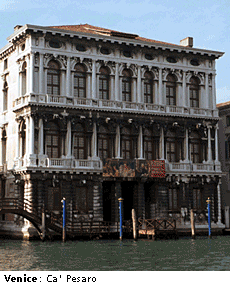Museums
The most interesting museums in Venice, divided into city areas, from the Galleria dell’Accademia to the Peggy Guggenheim Museum...
Santa Croce
- The Museum of Modern Art and the Museum of Oriental Art.
The Museum of Modern Art and the Museum of Oriental Art in Venice are housed in the wonderful seventeenth-century building known as Ca’ Pesaro, a true example of Venetian Baroqe style, designed in 1628 by Baldassare Longhena.
The Modern Art Gallery has an interesting collection of paintings and sculptures by nineteenth and twentieth century artists such as: Kilmt, Chagall, Kandinsky, Klee, Matisse, Moore, Mirò, Morandi, De Chirico, Rodin.
On the second floor there is a large collection of oriental art pieces, divided into two sections: China and Indonesia on one side and Japan on the other.
Dorsoduro
- Peggy Guggenheim Museum
The Peggy Guggenheim Museum is a foundation that is housed inside Palazzo Venier dai Leoni, a typical building with just one floor that looks out onto the Grand Canal. In 1954 Peggy Guggenheim (1898-1979), a collector and patron of many modern artists, bought the building to live in, transferring her own collection of sculptures and paintings by artists such as Mirò, Magritte, Boccioni, Picasso, Chagall, Mondrian, Kandinsky, Ernst, Dalì. Today these works of art can be visited at the Peggy Guggenheim Foundation, the best Museum of Modern Art in Venice: 400 works of art, including paintings and sculptures.
- Academy
The Academy of Fine Arts was set up on September 24th 1750, headed first by Piazzetta and then by Tiepolo. In 1807, a true art gallery was set up inside it, that served two purposes: it offered important models for the Academy’s students and also housed the artistic inheritance left by the public buildings that were dismantled after the Venice Marine Republic fell from power. At the end of the Second World War, the architect Carlo Scarpa redesigned the Academy. There is a full range of existing Venetian paintings inside. The original collection has been added to with religious artifacts, private heirlooms, restored paintings and paintings that were bought elsewhere.
When you come out of the main entrance of the Academy you can see the dell’Accademia Bridge, one of the three bridges, together with the Rialto and the degli Scalzi bridges, that cross over the Grand Canal.
Castello
- Arsenale (The Shipyards)
The Venice Arsenale were built around 1104 and was then extended over three centuries, to a point where they took up a large area of the Castello sestiere. The Arsenale are made up of a set of buildings from where the Venetian war and merchant fleets set off.
The entire shipyard area was surrounded by high walls, protected by square towers that had winged lions on the top. The large archway at the entrance was built by A. Gambello when the Doge Pasquale Malipiero (1460) ruled the Republic. Above the main door there is a stone statue of a winged lion with a sword and bible that is open on the words “pax tibi Marce evangelista meus” (may peace be with you, Mark, my evangelist), which is the symbol of Venice.
In 1682 a terrace was built from where it is possible to see the square below and there are eight allegorical stone statues on the rails of gods and goddesses.
When the shipyards were at their busiest, there were 16,000 men working in these yards, who were given the name Arsenalotti. They were divided into teams of joiners, sawyers and stucco decorators who could prepare up to six large trading galleys ships every two years. In the 14th century, many warehouses were built to make and store ropes and rigging: one of these was called “la Tana”. Hemp plants were separated inside “la Tana”, which were then used to make strong ropes by the master rope makers.
Venice was the main naval center on the Adriatic Sea until 1797. The Serenissima came to an end following the Napoleonic wars and the Austrian occupation, and the shipyards were slowly abandoned.
Today it is possible to see models of the Serenissima ships in the Venice Shipyards museum.
San Marco
- Correr Museum
The Correr Museum, which is located in the Napoleonic Wing of Piazza San Marco and in a part of the Procuratie, houses several items and findings that tell the story of Venetian art and history. In the part of the museum that takes up the magnificent Neoclassical rooms of the Napoleonic Wing there is a wonderful collection of sculptures by Canova. The part of the museum that is in the new Procuratie holds an exhibition showing various aspects of the city: it is possible to observe the Serenissima trading and the traditional Venetian festivals.
Go to directories of the Web Sites
Go to the itinerary:
|


